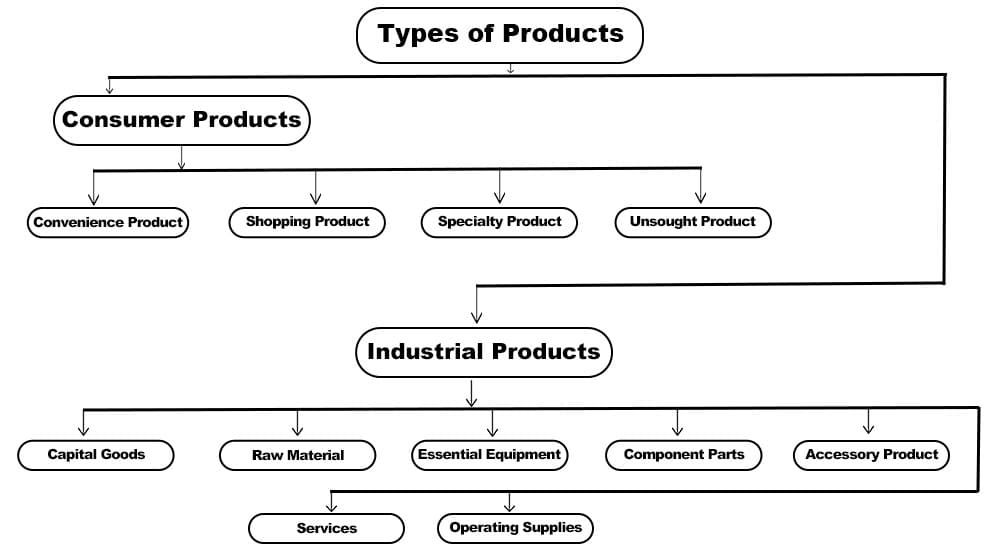There are two types of products – consumer products and industrial products. Consumer products are bought by individuals for their own use, while industrial products are bought by businesses for their operations.
The difference between the two types of products is significant, and it impacts how they are marketed.
This post will discuss the differences between consumer and industrial products and give examples of each product type.
What is a Product?
A product is a tangible item manufactured to be sold or used. Products can include cars, clothes, food, furniture, etc.
Manufacturing a product requires many steps, including designing the item, obtaining the necessary materials and components, packaging the product, etc. Products also require testing to ensure that they meet quality standards.
Products are sold through retailers or distributors, who then sell them to consumers or other businesses. Consumers can buy products directly from a manufacturer or purchase them through a retailer.
Manufacturing products is the most common type of business. Some companies produce only one type of product, while others produce different products.
The difference between products and services is that products are tangible, while services are intangible. Products tend to last longer than services, requiring more planning and investment.
Services are delivered immediately after placing the order and are a better option for certain businesses.
Types of Products
Products can be grouped into two categories:
- Consumer Products
- Industrial Products

Consumer Products
A consumer product is a good or service that customers buy for personal use. Consumer products can include anything from food and clothing to cars and electronics.
These products are mass-produced and sold through retailers, such as supermarkets and department stores. However, some consumer products, such as handmade jewelry or furniture, may be sold directly by the producer or a small retail shop.
Consumer products are further divided into four categories:
- Convenience products
- Shopping products
- Specialty items
- Unsought products
#1. Convenience Products
Convenience goods are low-cost purchases that serve an immediate need, such as chocolate bars, soda cans, etc. Consumers buy convenience goods without much thought.
Many products in the convenience category are “daily needs” products, such as toiletry items and food. Convenience products are low-priced and easy to find in stores.
For example, consumers can find toiletry items like shampoo, toothpaste, and soap at any convenience store. Most convenience stores also store food items like cereal, bread, and milk.
Convenience products can further be divided into three categories:
Staple Products
These are food and beverage items, like milk or eggs. Consumers buy these products without thinking much since they know the cost and where to find these products.
However, these products are still convenient because consumers can get them from different stores. For example, eggs and milk are available at supermarkets, convenience stores, and even gas stations.
Impulse Products
These are small items placed near a checkout counter that consumers buy without much thought. Candy bars, gumballs, magazines, or newspapers – these fall into the impulse products category.
Emergency Products
Consumers buy these products when they need them. This might include items like batteries, light bulbs, or aspirin.
#2. Shopping Products
Shopping for these products requires more thought from the consumer. Consumers buy these products for special occasions or specific tasks.
These products can include anything from clothes to cars. They have a higher price than convenience products.
For example, consumers don’t buy a new outfit every day. They purchase outfits every few months from a clothing store.
Another example of a shopping product is a new laptop. They’re not as easy to find as a chocolate bar. Consumers do research before purchasing a laptop. They would consider things like price, brand, and features before purchasing.
Shopping products can be further divided into two categories:
Homogeneous Shopping Products
These products are the same for consumers because of similarity in features, functionality, and quality. For example, washing machines may be considered homogeneous shopping products because they have the same features and functions.
Heterogeneous Shopping Products
These products vary in terms of pricing, quality, and style. An example would be clothing, where consumers have different brands, styles, and pricing options. Consumers can research when shopping for clothing because of budget and style options.
#3. Specialty Products
These goods usually have unique features or benefits that differentiate them from other products.
Consumers are willing to pay higher prices for these goods since they have added benefits or features that other products don’t offer. For example, an expensive watch with a diamond face and platinum band is a luxury item that consumers don’t buy regularly.
They’re not as easy to find as convenience goods; consumers research before purchasing. Some specialty items include luxury cars like Mercedes Benz or BMWs, designer clothes from Gucci and Prada, Rolex watches, and other high-end electronics like Apple products.
#4. Unsought Goods
These are products that consumers don’t usually buy unless they require them. For example, people may not purchase life insurance until they are married. After learning how much money they could save in taxes, they might buy it.
Industrial Products
An industrial product is a product designed for use by other businesses. They’re not for retail sale to the public; they’re purchased by businesses that use them in production and sell them as part of a larger product.
Common industrial products are machines, tools, equipment, chemicals, and packaging components. Generally, companies don’t sell these products to consumers; they produce them for other businesses.
Industrial products can be made from various materials, including metals, plastics, composites, and even raw natural materials like wood or stone. The most common industrial products are metal parts and tools, electronic components, chemicals, and packaging materials.
These products serve a specific purpose in larger manufacturing or production processes.
The most common industrial products have a long lifespan. They last for years or decades without requiring any major repairs or replacements. They can also be mass-produced, meaning that many of them will simultaneously end up being used by different companies.
Industrial products can be further divided into subcategories:
- Raw materials
- Capital products
- Essential equipment
- Component parts
- Accessory products
- Services
- Operating supplies
#1. Raw Materials
Raw materials are used directly from their natural state without processing or further refinement. The term “industrial” is often associated with large-scale mining and extraction of these resources, such as iron ore for manufacturing steel or coal to fuel power plants, but it can also include smaller-scale operations like forestry and fishing.
#2. Capital Products
Capital products are items used to create other industrial or commercial products. This might include machine tools, dyes, molds, chemical processing equipment, or entire factories.
#3. Essential Equipment
Essential equipment is any machinery or tool necessary for a particular production process. This might include metalworking machines, printing presses, or assembly robots.
#4. Component Parts
Components are the individual pieces that make up a larger industrial product. These can be small screws, bolts, entire engines, control systems, etc.
#5. Accessory Products
Accessory products aren’t essential for a particular production process, but they can make it more efficient or easier to use. This might include safety goggles, tool belts, or precision measuring instruments.
#6. Services
Services are the people and companies that provide support for industrial products. This might include maintenance crews, engineering consultants, or parts suppliers.
#7. Operating Supplies
Operating supplies are the items that are necessary to keep an industrial production process running smoothly. This might include things like lubricants, solvents, or packaging materials.
Differences Between Consumer Goods and Industrial Goods
The first difference between consumer goods and industrial products is how they are used. Consumer goods are purchased for personal use, while industrial products are purchased for business purposes. For example, a car is a consumer product because it is used for personal traveling. In comparison, a truck is an industrial product because it is used to transport goods.
The second difference between consumer goods and industrial products is their purpose. Consumer goods are purchased to satisfy personal needs, while industrial products are purchased to meet some sort of business need. For example, a person buys a new shirt to look good at work, while a business buys an industrial product for their business operations.
Another difference between consumer goods and industrial products is how they are distributed. Consumer goods typically go through distributors, wholesalers, or retailers, whereas industrial products are usually shipped directly from the factory to the customer. For example, a car might be sold in stores or online, while an industrial product might be shipped directly from the factory to a business.
Cost is another difference between consumer goods and industrial products. Consumer goods are usually less expensive than industrial products because they do not require as much labor or material costs to produce them. For example, a car would cost less than an industrial product like a tractor-trailer truck.
Conclusion
Businesses need to classify their products correctly to develop effective marketing strategies. The two types of products we have covered in this article are consumer products and industrial products.
Consumer products are typically bought by individuals for personal use, while organizations purchase industrial products for use in their business operations.
